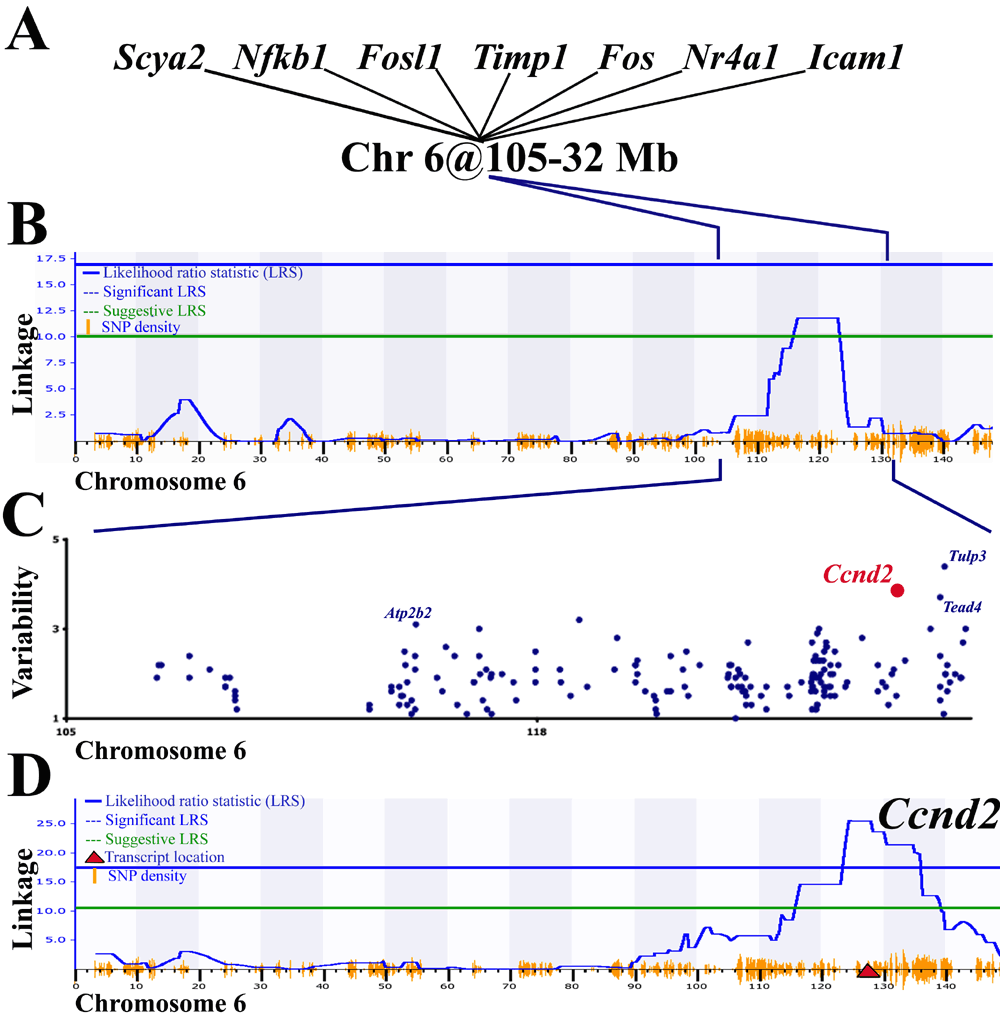![]() Figure 4 of
Vazquez-Chona, Mol Vis 2005;
11:958-970.
Figure 4 of
Vazquez-Chona, Mol Vis 2005;
11:958-970.
Figure 4. Evaluating candidate genes within Chromosome 6 locus
A: The transcript variability of Scya2, Nfkb1, Fosl1, Timp1, Fos, Nr4a1, and Icam1 in brains from BXD RI mouse strains is genetically linked to the regulatory locus on Chromosome 6. This network was generated by comparing genome-wide scans that measure the linkage of transcript variability across the mouse genome, as described in Figure 1. These transcripts are also upregulated as acute phase transcripts in retina, brain and spinal cord (Table 2). Transcripts genetically linked to the same regulatory loci and highly regulated in injured CNS are hypothesized to be part of a genetic network. B: The combined genome-wide map shows that their transcript expression has a strong genetic linkage to a locus within Chromosome 6, 105 to 132 Mb. The genome wide scan, zoomed at Chromosome 6, shows the genetic linkage (y-axis, likelihood ratio statistic [LRS]) across the chromosome (x-axis, Megabase pairs [Mb]). This locus includes over 200 positional genes, some of which have a high or low single nucleotide polymorphism (SNP) density. SNP density is denoted by the height of the orange lines on the x-axis. Several rules may help in selecting candidate gene responsible for this regulatory locus. The first rule is there have to be SNPs present within the coding or regulatory region of the gene of interest. As a first approximation we used SNP density that is displayed at the bottom of panel B and D. The second rule is a high degree of transcript abundance variability in the BXD RI strains (illustrated in C). C: Transcript abundance variability in normal forebrains of BXD RI mouse strains is due to genetic polymorphisms between the parental C57BL/6 and DBA/2J mouse strains. The graph illustrates transcript abundance variability (y-axis) for genes (dots) within the 105 to 132 Mb interval of Chromosome 6 (x-axis). The higher the variation in transcript abundance the more likely that the gene is a candidate. Furthermore we expect that the variability is due to a polymorphism in the candidate gene, suggesting that the polymorphic gene is modulating its own expression level (that is, a "cis-regulatory locus"). We measured transcript variability using an analysis of variance (ANOVA) that tests the between-strain variance compared with the total variance for 100 arrays from 35 mouse strains. The degrees of freedom for the between-group and total variance are 34 and 99. Strain-specific variation is significant (p<0.05) when F34,99>1.5. In the graph, each dot represents a gene with its variability measured by the ANOVA F-statistic (y-axis) and its genomic location within Chromosome 6 described in Mb. Tulp3, Ccnd2, Tead4, and Atp2b2 are polymorphic genes that displayed significant transcript variability and cis-regulatory loci in normal forebrains of BXD mouse strains. D: The third criterion identifies the genes that display self regulation across CNS tissues. For example, the transcript variability of Ccnd2 (red circle in C) displays a strong cis-regulatory locus in the forebrain (LRS=25, probe set 97504_at) and cerebellum (LRS=14, probe set probe set 1416122_at_A) of BXD RI mouse strains. Here we illustrate linkage of Ccnd2 transcript variability in BXD RI mouse strains across Chromosome 6. Red triangle indicates gene location. Atp2b2, Tulp3, and Tead4 also displayed cis-regulatory loci in brain and cerebellum (data available at GeneNetwork). The role of a candidate gene as a modulator of the Chromosome 6 and wound healing is further strengthen if its transcript is differentially expressed in injured CNS. Ccnd2 displays increased transcript levels in injured rat retina (data available at GEO data set GSE1001, probe set rc_AA899106_at) [1].
